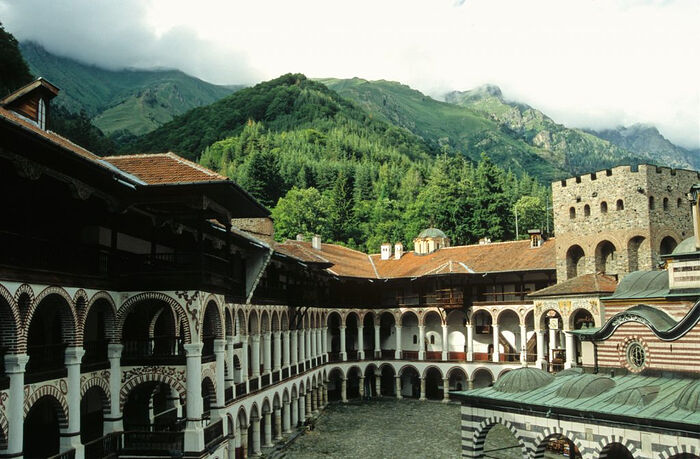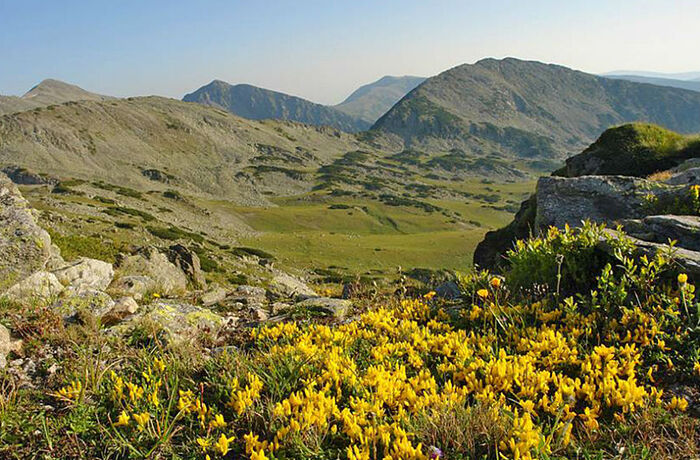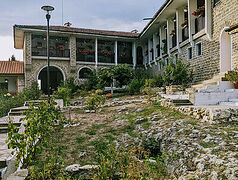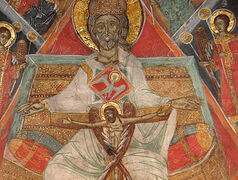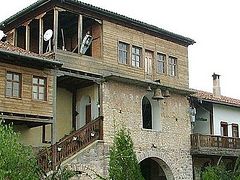In the spring of this year, Hieromonk Irenei (Pikovsky) from the Moscow Sretensky Monastery visited the Representation of the Russian Orthodox Church in Sofia. In this interview Fr. Inrenei shared his impressions of the ancient shrines of Bulgaria, his travels to places significant for the Church, and talks with local clergy.
—Fr. Irenei, was this your first visit to Bulgaria? Which shrines of the Bulgarian Orthodox Church did you manage to see?
—I was in Bulgaria for the first time, although I had dreamed of visiting the holy sites of this blessed land for a long time. I was born on the feast of the most venerated patron-saint of the Bulgarian people, St. John of Rila, and from the moment of Baptism I bore his name as my Heavenly intercessor. Of course, first of all I wanted to visit the site of the saint’s ascetic labors and the monastery where his relics repose. There were close relations between Rila Monastery and the Monastery of St. Panteleimon on Mt. Athos in the fifteenth century. And for many Russians, St. Panteleimon’s Monastery on Mt. Athos is the symbol of Russian Athonite monasticism. Until now, Rila Monastery has retained the spirit of Mt. Athos in its architecture and paintings. The Byzantine layout of the katholikon and the monastery courtyard are somewhat reminiscent of Zographou Monastery on Holy Mount Athos. By the way, the frescoes of the main church of the Monastery of St. John of Rila were painted by the greatest Bulgarian icon-painters of the nineteenth century: Zahari and Dimitar Zograf. When I entered the katholikon of Rila Monastery, I saw the stasidia typical for the Holy Mountain, and at that time a Romanian priest and his pilgrims were doing a prayer service, singing hymns in Byzantine chant.
The spirit of Mt. Athos is also felt when you are visiting the cave where St. John struggled. A winding rocky path leads there, from which you can see the slopes of the Rila Mountains covered with bright green trees. There are tall trees around, as if in a botanical garden. A pilgrim begins his journey from a mountain stream, which in some places forms real waterfalls. The ascent ends with a small Byzantine church and a kaliva in honor of St. Luke, St. John’s nephew. When I was visiting the site of St. John’s ascetic labors and Rila Monastery, it seemed as if I were on Mt. Athos, where everything breathes the mystery of Communion with God, the mystery of ascetic labors and the prayer of the heart, the building of a sober lifestyle and the cleansing of the heart from sin.
I was also impressed by Kazanlak Convent of the Entry of the Mother of God into the Temple and Chirpan Monastery of St. Athanasius the Great. Only a handful of elderly nuns live in the former, and one aged archimandrite resides in the latter. All of them are very sociable, happy to talk about the history of their communities and about how Russian people once helped them build or adorn their churches. When I wanted to order daily commemorations at the Liturgy for forty days and offered a donation, they refused my money, saying they would pray as a token of our Christian friendship. On the one hand, I felt somehow uneasy because they have poor churches (they heat with wood in a stove in the middle of the church), and at the same time they refused donations.
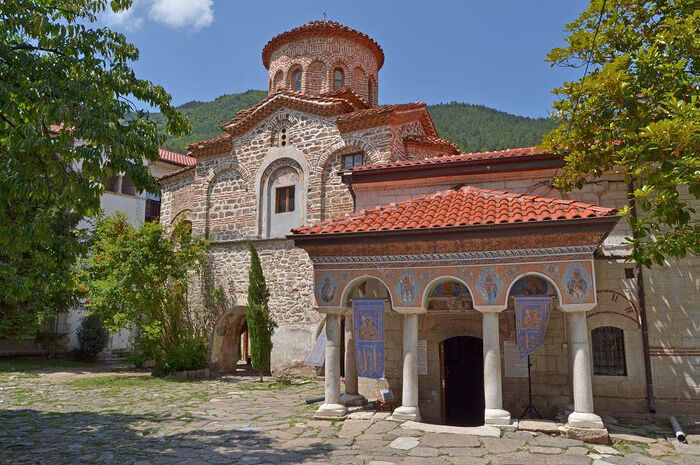 Kazanlak Convent of the Entry of the Mother of God into the Temple
Kazanlak Convent of the Entry of the Mother of God into the Temple
On the other hand, looking into the eyes of these elderly ascetics, I understood that they had come here at the call from above, and for them, monastics’ mutual prayer for each other was more precious than money. My companion, a Bulgarian who had studied at the Iconography Department of the Moscow Theological Academy, and I, did not stay in these monastic churches for long. But there, as in the parish churches of the small towns of the Stara Zagora Metropolis, people would come in to light candles and ask questions. It was gratifying to see that despite the small number of priests and monks in the diocese, there was interest in them as in some kind of mystery that is covered with a divine veil.
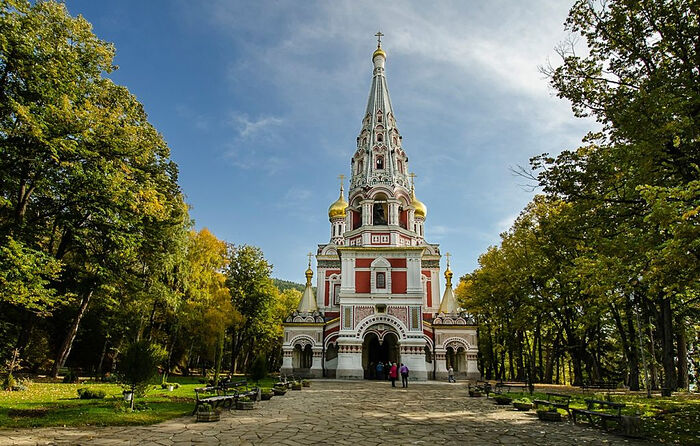 Church-Monastery of the Nativity of Christ near Shipka
Church-Monastery of the Nativity of Christ near Shipka
It is also hard to forget the church-monument of the Bulgarian-Russian friendship in honor of the Nativity of Christ near the town of Shipka. They even planned to open a theological seminary there, but due to diplomatic reasons they did not do it. Now this place is called a monastery, although there are few monks there. Some decorative elements and the significance of this huge church in the history of the Bulgarian people reminded me of the Plevna Chapel in Moscow: a monument to the Russian grenadiers who fell during the Siege of Plevna in the Russo-Turkish War of 1877–1878. Since Sretensky Monastery is not far from Ilyinsky Square in Moscow, I often pass by the Plevna Chapel. This chapel, like the Nativity Church in Bulgaria, contains symbols of the joint struggle of the Russian and the Bulgarian peoples against the Ottoman yoke. Marble slabs with the names of the units that fought for the liberation of Shipka are installed inside the church, and nearby you can see the old cemetery, where officers and soldiers of the Russian Imperial Army, who ended up in Bulgaria after 1917 and lived at Shipka Monastery in a home for severely disabled and elderly soldiers, are buried. The monument at the Shipka Pass offers spectacular views.
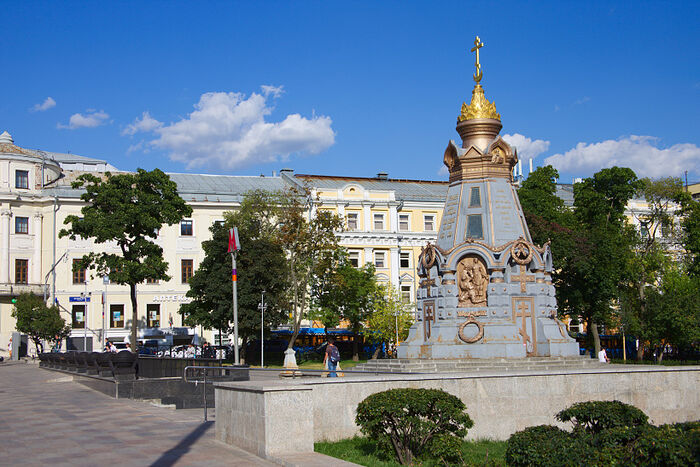 The Heroes of Plevna Monument, Kitay-Gorod, Moscow
The Heroes of Plevna Monument, Kitay-Gorod, Moscow
It seems to me that the ancient saints, like the heroes of our days, unite our peoples and serve as a motive for the same presentation of materials in lessons on the history of both our countres at schools.
—You were in the cave of St. John of Rila. What did you notice in common with the organization of the lives of our Russian ascetics?
—Yes, there was much in common with our saints who struggled in caves. His cave is situated on the slope of a mountain in the forest, where anyone can get lost. There was a hole at the top of the cave for the flow of fresh air and for the evacuation of smoke from a fire. A river flows nearby, and there is also a spring. All cells of this type—those of Sts. John Climacus, Dionysius of Olympus and John of Rila—are very similar in their structure.
The pattern of development of these monasteries is also similar: first, a hermit comes to a secluded place. Then lay people, his spiritual children and disciples, join him and settle nearby. The hermit does not know what coenobitic life is like; however, a coenobitic monastery is organized nearby. There is a certain pattern: running from worldly glory, a person receives Divine glory; running from worldly wisdom, he receives Divine wisdom; and in order for these gifts of God to shine he creates the conditions in which he leads a concentrated, sober lifestyle. The cell of St. John of Rila was a typical example of this logic.
—Please share your impressions of your visit to the Representation of the Russian Orthodox Church in Sofia.
—As you know, the Church of St. Nicholas the Wonderworker, consecrated in 1914, is the Representation Church of the Russian Orthodox Church in Sofia. The first thing that caught my eye was the large number of Bulgarians who came to the church on a weekday to pray and venerate the relics of St. Seraphim, Archbishop of Boguchar and the Wonderworker of Sofia. The saint of God graduated from the Ryazan Theological Seminary, was then the inspector of the Kostroma Seminary and the rector of the Voronezh Theological Seminary. At the St. Seraphim Skete of Sretensky Monastery in the Ryazan region, seminary courses are also organized, and in Moscow future pastors are trained by the Sretensky Theological Academy. The field of spiritual enlightenment invisibly unites St. Seraphim (Sobolev) with Sretensky monastery.
 St. Nicholas Church of the Representation of the Russian Orthodox Church in Sofia
St. Nicholas Church of the Representation of the Russian Orthodox Church in Sofia
On the day of my visit, many people gathered for a prayer service at the holy hierarch’s relics. There were both representatives of the Russian Embassy and of Bulgarian patriotic public organizations. At the same time, both Russians and Bulgarians testified that miracles of healing occur through prayers to the holy hierarch. There is a Sunday school at the Representation of the Russian Orthodox Church in Sofia, and Russian language is taught there. The parishioners I met at the church were very friendly, pious and spoke good Russian. A church with a prayer-soaked atmosphere and beautiful frescoes, a marvelous choir who sang at the prayer service, the Russian and Bulgarian priests who make up a united team as clergy, a hospitable rector, Archimandrite Vassian (Zmeyev)—all this left an indelible and most pleasant impression from visiting the Representation of the Russian Orthodox Church in Sofia.
To be continued…

